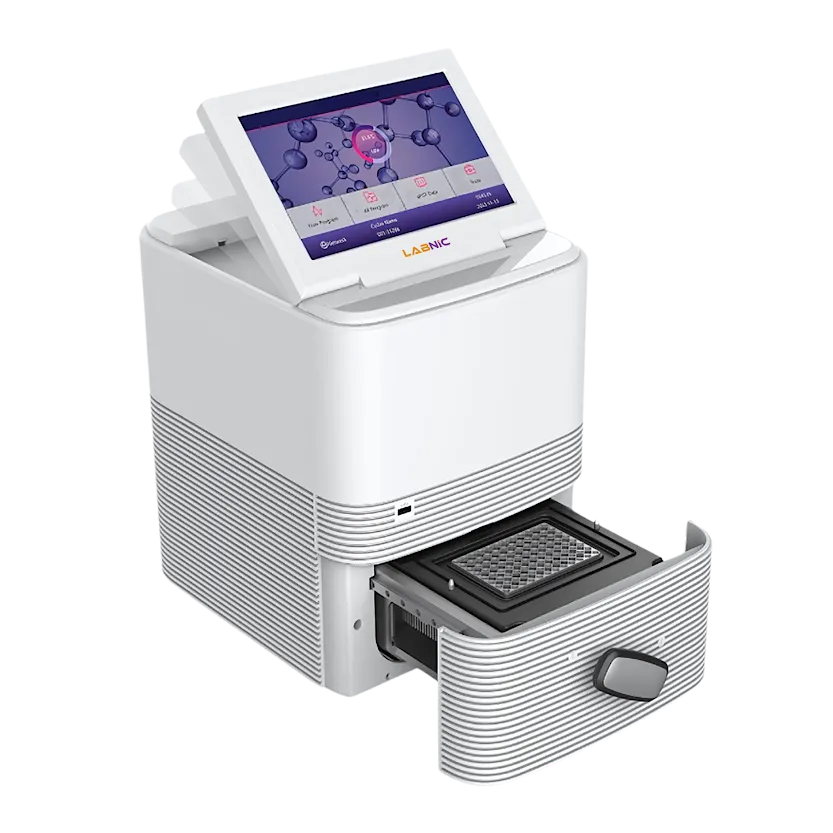
PCR Thermal Cycler LBN-PT152 is a high-performance machine designed for accurate and efficient real-time PCR analysis. It supports 96-well × 0.1ml plates and a reaction volume range from 10 to 50 µl for efficient sample processing. Equipped with a high-resolution imaging system and a slide out tray for easy handling. Integrated smart software enables test execution, live monitoring, and automatic setting storage. Our PCR Thermal Cycler is ideal for gene expression, DNA quantification, microbial load testing, and molecular diagnostics in research, clinical, pharmaceutical, and environmental labs.
| Capacity | 96-well × 0.1ml |
| Reaction Volume | 10 to 50 µl |
| Tube Type | 90.1ml PCR Plate with Optical Flat Cap |
| Block Temperature Range | 0℃ to 105℃ |
| Heat Lid Temperature Range | 30℃ to 112℃ |
| Temperature Accuracy | ≤ ± 0.1℃ (90℃) |
| Temperature Uniformity | ≤ ± 0.2℃ (90℃) |
| Gradient Range | 30℃ to 100℃ |
| Temperature Differential Range | 1℃ to 30℃ |
| Display Resolution | 0.1℃ |
| Display | 10-inch Colour TFT LCD and Touchscreen |
| Power Supply | 100 to 240V, 50/60Hz |
| Package Dimension | 334×280×365mm |
| Net Weight | 13 kg |
PCR Thermal Cycler LBN-PT152 is ideal for gene expression, DNA quantification, microbial load testing, and molecular diagnostics in research, clinical, pharmaceutical, and environmental labs.
PCR Thermal Cycler LBN-PT152 is ideal for gene expression, DNA quantification, microbial load testing, and molecular diagnostics in research, clinical, pharmaceutical, and environmental labs.
Most Frequently Asked Questions
1. How does a PCR thermal cycler work?
Ans. It works by repeatedly heating and cooling samples to specific temperatures, enabling DNA denaturation, primer annealing, and extension to create multiple copies of the target DNA sequence.
2. What are the main components of a PCR thermal cycler?
Ans. The main components include a thermal block to hold samples, a heating/cooling system for temperature changes, and a control panel for programming cycling parameters.
3. Why is precise temperature control important in a PCR thermal cycler?
Ans. Precise temperature control ensures accurate DNA amplification by maintaining optimal conditions for denaturation, annealing, and extension during the PCR process.
4. How long does a PCR reaction take?
Ans. A standard PCR reaction usually takes 1 to 3 hours, depending on the number of cycles, annealing temperature, and type of DNA polymerase used.
5. How many samples can be processed at once in a PCR thermal cycler?
Ans. The capacity depends on the model, but most thermal cyclers can hold 24, 48, or 96 reaction tubes in a single run.
PCR Thermal Cycler LBN-PT152 is a high-performance machine designed for accurate and efficient real-time PCR analysis. It supports 96-well × 0.1ml plates and a reaction volume range from 10 to 50 µl for efficient sample processing. Equipped with a high-resolution imaging system and a slide out tray for easy handling. Integrated smart software enables test execution, live monitoring, and automatic setting storage. Our PCR Thermal Cycler is ideal for gene expression, DNA quantification, microbial load testing, and molecular diagnostics in research, clinical, pharmaceutical, and environmental labs.